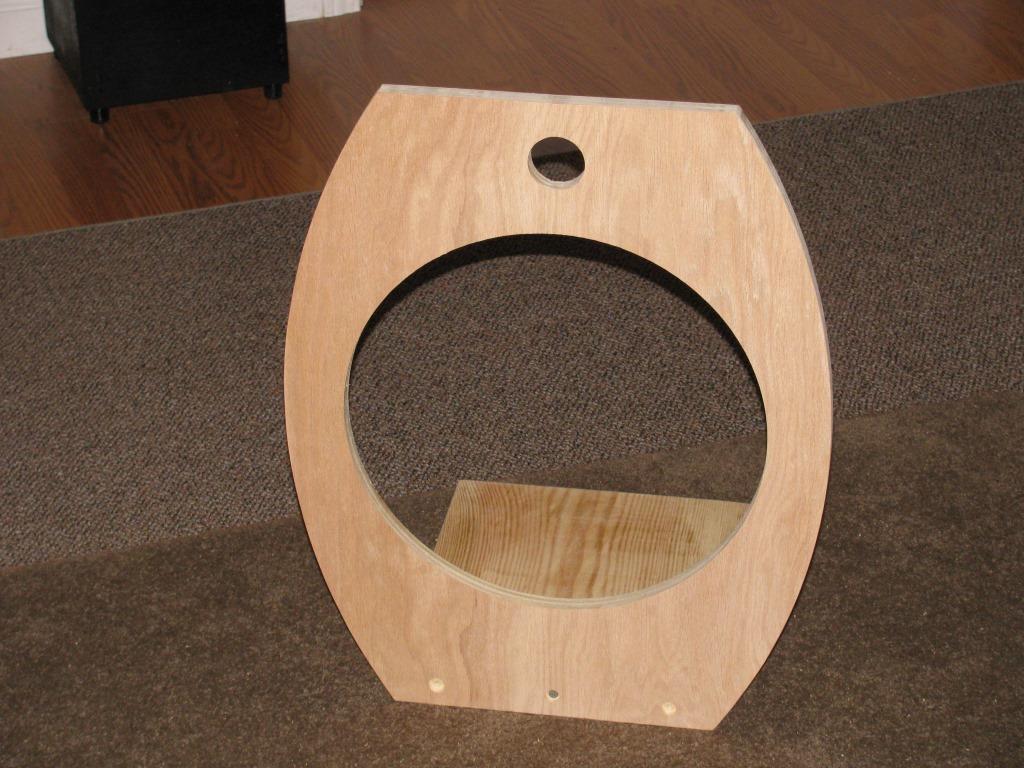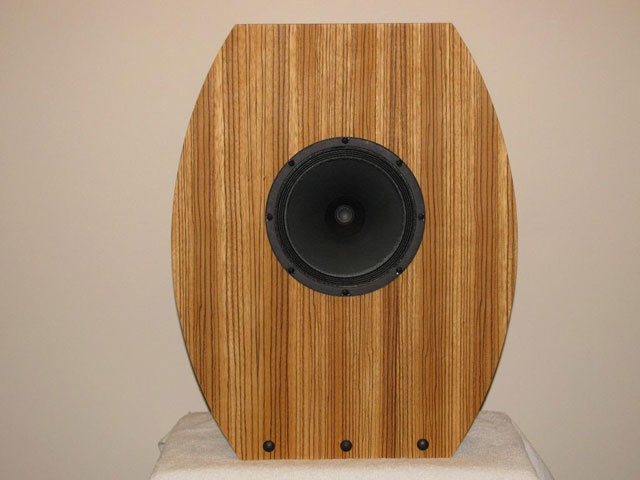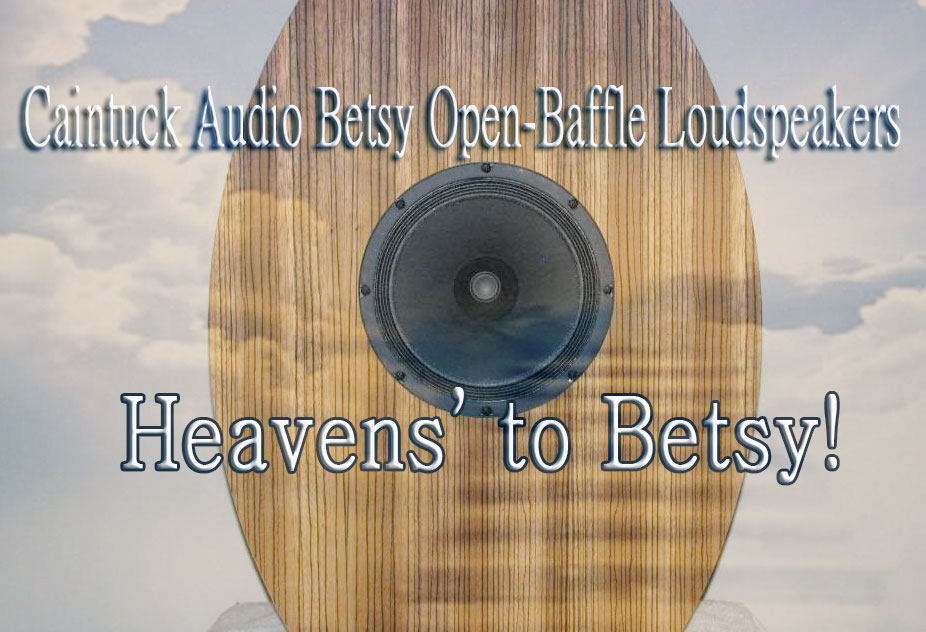Caintuck Audio Betsy Open-Baffle Loudspeakers

Recently, Mick W, one of my audiophile friends in a small group we have here in the Tucson area sent me an ad from DECWARE advertising the Caintuck Audio “Betsy” open-baffle loudspeakers for a mere $450 per pair.
This intrigued me since I am curious about open-baffle designs and also because the price was so low for decent quality pair of audiophile speakers. As it turned out, speaking directly with Caintuck’s Randall Rash, my review pair of the Betsy’s in the Sapele finish (an attractive African hardwood) does in fact retail factory direct for $450/pr and he even had stained plywood versions available for only $350/pr. Hallelujah brother! The prices that DECWARE charges appear to be the same as if you purchased them directly from Caintuck Audio—with the possible advantage that you could also buy a nice little tube amp from DECWARE to make the Betsy’s sing.
To be sure, the Betsy’s are built to a very attractive price point. The Betsy’s bases, made from 2” by 12” stock work fine and look okay (not that you can see them from looking at the speaker from the front). But in the exotic world of high-end audio, a more upscale base with a less resonant binding post “box” would be nice possible upgrades. That said, the lower cost of those materials did not seem to affect the sound very much if at all.


The Betsy’s main and only driver is an 8-inch full-range unit with a whizzer cone for extending the high frequencies without using a crossover. Two leads from the speaker to the binding posts is all that is required for connecting to an amplifier. Betsy’s driver is impregnated with carbon-fiber to improve stiffness, and both the cone and the motor assembly are very light weight for faster-than-usual transient response.
For you DIYer’s, the drivers themselves are sourced from Wild Burro Audio and as of this writing there is a 2-month wait for delivery if you’d like to try to build your own speakers.
The thing about open-baffle speakers is that they radiate sound both front and rear and eschew the typical box enclosure to achieve a very open sound—sort of like a Magneplanar, but using conventional drivers. The trade off is normally less bass extension (as it is in this case). But in view of the Betsy’s coherency, super-fast transient response, and holographic imagery, I’d say this trade-off is well worth it. Besides, as it happens, the Betsy’s bass performance, which begins a mild decline at about 80Hz still seemed to have satisfying bass output to below 50Hz in my room with the room gain taken into account. And as I said the bass is very detailed and articulate. Of course it almost goes without saying that the bass freaks among us will probably want to add a subwoofer for extra bass extension, but I enjoy the Betsy’s bass just as it is.
On the Caintuck Audio website they picture matching open baffle 15-inch woofers (at extra cost) to compliment the Betsy speakers. I did not have the extra woofers for my evaluation, but they look quite cool and are available in the same finishes as the Betsy’s.
Randall claims his open-baffle subs mate better with the Betsy’s than other box-type woofers. He sells two subwoofer models, one with either a 12” or 15” Eminence Alpha bass driver for only $150, and another that uses a Hawthorne Audio Augie 15” woofer for $350. Additionally, he can source a Dayton Audio SA-100 plate amp and attach it to the rear base of either subwoofer model for only $125 extra.

The System
 In keeping with the “budget” theme, I first tried a couple of lower cost options with the Betsy’s. I used my Lenovo laptop computer (with a USB cable and replacement 5V supply by JMaxwell Audio) as the music source feeding the modified Jolida Glass FX Tube DAC III, which, in turn fed my amplifiers.
In keeping with the “budget” theme, I first tried a couple of lower cost options with the Betsy’s. I used my Lenovo laptop computer (with a USB cable and replacement 5V supply by JMaxwell Audio) as the music source feeding the modified Jolida Glass FX Tube DAC III, which, in turn fed my amplifiers.
I started with my 80 watt/channel custom Tripath amplifier, which gave very impressive sound. Later I moved to a DECWARE Super Zen Triode single-ended tube amplifier using a tube rectifier and two Russian output tubes similar to the EL84. The amplifier is rated at only 2 watts/channel, and while it sounded quite dynamic, detailed, and amazingly good in most ways I found myself wanting for a touch more meat on the bones. But then, I did have the Betsy’s set up in my large 14’x30’ room, which I’m sure was challenging for the 2-watt Super Zen Triode amp to adequately fill. Mind you the Betsy’s sensitivity spec is only 92.4 dB @ 1 watt input—though it’s volume does not drop off as rapidly with distance as with conventional speakers.
Later on I tried my modified Dignity Audio 300B mono amps rated at 8 watts each. Surprisingly those amps played the Betsy’s fairly LOUD in my large room without any obvious signs of distress. I will mainly comment on the Betsy’s sound quality using the Dignity 300B’s. And though the Betsy’s played at a healthy level in my large room they do have their limits and are not intended as “high output” speakers.
The Betsy’s don’t come with any type of feet, but DECWARE’s Steve Deckert had pre-installed a tripod of rubber feet that you can typically find at any hardware store. I was installing them on padded carpet so I put two Black Diamond Racing carbon fiber cones under the left and right sides of the front baffle to give them a slight tilt back (since the Betsy’s are not very tall). I also put a 5-pound weight on the rear center of the base to provide more stability. This all worked very well. Before I installed the BDR cones and rear weight I used Betsy’s rear handle to move the speakers around so I could find the best-sounding position for their imaging and frequency balance.
I also tried the 2-watt DECWARE Super Zen Triode amp in my Small-Room System on my Wavetouch Audio Grand Teton SE speakers and it threw a huge layered soundstage and some of the sweetest, most extended high frequencies I’ve ever had the privilege to hear.
Consequently, Steve Deckert has agreed to send me a second Super Zen Triode amplifier so I can run the resulting pair in bridged mono, which will bring the power output to 6 watts for each amplifier. I suspect the bridged Super Zen amps will work very well with the Grand Teton SE’s (and the Betsy’s for that matter) and I will be doing a full review of the Super Zen Triode amplifiers sometime in the near future. Steve D assures me that the image density will improve with no loss in transparency.
The Sound
Beginning with Eva Cassidy’s “Wade in the Water,” Eva’s voice came to life with very wide dynamic contrasts. When she changes her volume level and you can tell when she’s belting it out, cruising along, or pulling back from the microphone. With this wonderful sense of dynamic flavor the music almost seems to breathe. Also on this particular track, the trumpet sounds very natural and when the musician triple-tongues it, it’s very easy to hear due to the fast transient speed of the Betsy’s nimble driver.
The treble is generally airy. Cymbals shimmer, and high frequency percussive instruments like bells, triangles, and drumsticks clicking together are both plausible and poignant. The Betsy’s don’t have the last word in high frequency extension or refinement as compared to more expensive speakers with top notch ribbon or beryllium treble drivers but I don’t think you will find many speakers that provide more convincing highs in the Betsy’s price range.
That said, the Betsy’s do seem a bit prominent in the lower treble, which gives them a slightly forward sound with some treble-rich material. This is part of what gives the Betsy’s their lively sound—with the other part being their dynamic nature.
I did notice that the Betsy speakers are particularly adept at reproducing many types of guitar playing. Whether it’s acoustic or electric and whether the strings are being strummed, plucked, or thwacked, the Betsy excels at providing a super-convincing guitar sound. Again, the Betsy’s lightning-fast transient speed and dynamic capability are on display. Playing recordings from Jimmy Vaughn, Mick Fleetwood, and John Mayer, showcased the Betsy’s talent for providing lifelike guitar sound.
.png?KeepThis=true&TB_iframe=true&height=430&width=700) I’m quite familiar with the sound of John Mayer’s Continuum CD (AWARE/Columbia 82876 79019 2) and I have to reluctantly admit that the Betsy’s outclassed many much more expensive speakers with their exquisite rendition of Mayer and his band on this well-known album. Songs like “Waiting on the World to Change,” “Belief,” and “Gravity” sound like you’re there at the concert. Just check out the bass line on “Belief” when you have a chance. Although the Betsy’s don’t provide the deepest bass, the speed and articulation of the bass guitar and drums may just knock you back in your seat a bit. As far as imaging goes, the Betsy’s will not disappoint. They can layer a deep and wide sonic portrait like nobody’s business—and probably throw in a few small nuances you hadn’t noticed before. They are really that good.
I’m quite familiar with the sound of John Mayer’s Continuum CD (AWARE/Columbia 82876 79019 2) and I have to reluctantly admit that the Betsy’s outclassed many much more expensive speakers with their exquisite rendition of Mayer and his band on this well-known album. Songs like “Waiting on the World to Change,” “Belief,” and “Gravity” sound like you’re there at the concert. Just check out the bass line on “Belief” when you have a chance. Although the Betsy’s don’t provide the deepest bass, the speed and articulation of the bass guitar and drums may just knock you back in your seat a bit. As far as imaging goes, the Betsy’s will not disappoint. They can layer a deep and wide sonic portrait like nobody’s business—and probably throw in a few small nuances you hadn’t noticed before. They are really that good.
But of all their many talents, I believe the area where the Betsy’s truly excel lies in providing outstanding vocal performance with both male and female singers. Listening to all my “heavy-hitter” vocal tracks from the likes of Ella Fitzgerald, Ingrid Michaelson, Regina Spektor and, of course, Israel Kamakawiwo’ole’s famous rendition of “Somewhere Over The Rainbow,” it became apparent that the Betsy’s might just be a vocal aficionado’s wet dream. And any verbose description I can offer would likely be inadequate. No joke!
Caveats
Okay, for a scant $450/pair, the Betsy’s are not perfect; no surprise there. But for me, they serve the music in a way that almost no other speaker anywhere near their price will be able to compete with. These are high-fidelity speakers, not PA speakers, so although they will play at healthy sound levels, if you are a head banger and want sound that will vibrate your whole body the Betsy’s won’t do that (nor are they intended to). As I mentioned the Betsy’s don’t delve into the deep bass or the highest highs, but they are well balanced and exceptionally musical. In the bulk of the audio range they do very well indeed.
It probably would be a nice thing for Caintuck Audio to provide some type of footers (whether cones or points) with the speakers even if they need to charge a little more. As I noted I used my own Black Diamond carbon-fiber cones but not everyone will have those lying around. An unusual thing I encountered with the Betsy’s was a kind of high-frequency vibration that I believe is caused by the whizzer cone. It’s hard to describe but is like a kind of vibrational emphasis on the sibilant energy on a few of my vocal recordings (in a very narrow band, perhaps the 3kHz area). This seemed to diminish quite a bit with more break-in hours. In fact I hardly notice it at all anymore on my review pair.
If you hear a strange buzz or emphasis on sibilants just keep playing the speakers and it should calm down. And I have only heard it on a very small percentage of the many recordings I’ve played. A slight repositioning of the angle of the offending speaker can also help.
Conclusion
I found the Betsy’s to be very revealing and musical speakers. Through them, I could hear some subtle details (some deep in the background) that I had not experienced with many other speakers. While their overall frequency response curve falls a bit short in extension into the deep bass and highest audible highs, if care is taken in the speaker’s in-room placement, the Betsy’s provide a nicely balanced and musical presentation. In fact, in my estimation the unassuming Betsy’s compete with some of the best loudspeakers I’ve experienced in terms of transient speed, low-level detail retrieval, holographic layered imagery, dynamic contrasts, and engaging lifelike immediacy.
As crazy as it sounds I find that in the parameters I named above, the Betsy’s can surpass or compete on a level field with many speakers at 5x to even 10x their super-low asking price. While a few companies are manufacturing open-baffle designs with 10” to 15” drivers, I was told (and based on my experience with the Betsy’s tend to believe) that the optimum driver size for an open-baffle speaker of this type is closer to that of the Betsy’s 8” unit, all things considered.
And honestly, the Betsy’s are just too much fun for words, so how could I resist buying the review pair? Clue: I surely could not!


Manufacturer
Caintuck Audio
7926 Alexandria Pike
Alexandria, KY 41001
Phone: 859-620-7274
e-mail: Caintuck.OB@outlook.com
See Also: DECWARE
75 S Riverview Drive
East Peoria, IL 61611 USA
Phone: 309-822-5255
Web: http://www.decware.com/newsite/homepage.html
Caintuck Betsy Loudspeakers
Sensitivity: 92.4dB/watt
Nominal Impedance: 5.9 Ohms
Wild Burro Audio “Betsy” 8-inch carbon-impregnated full range driver with whizzer cone
Dimensions: 22.5”H x 18”W x 12”D (base platform)
Price: Depends on finish. $350/pr for stained plywood. $450 for Sapele (review samples)
And up to $500/pair for other hardwood finishes. Contact Randy at Caintuck Audio for more information
Note: Caintuck Audio also sells matching 12” and 15” open-baffle subwoofers (not tested) for the Betsy’s.
One thought on "Caintuck Audio Betsy Open-Baffle Loudspeakers"
Leave a Reply
Stereo Times Masthead
Publisher/Founder
Clement Perry
Editor
Dave Thomas
Senior Editors
Frank Alles, Mike Girardi, Russell Lichter, Terry London, Moreno Mitchell, Paul Szabady, Bill Wells, Mike Wright, and Stephen Yan,
Current Contributors
David Abramson, Tim Barrall, Dave Allison, Ron Cook, Lewis Dardick, John Hoffman, Dan Secula, Don Shaulis, Greg Simmons, Eric Teh, Greg Voth, Richard Willie, Ed Van Winkle, Rob Dockery, Richard Doran, and Daveed Turek
Site Management Clement Perry
Ad Designer: Martin Perry






Thank you for your detailed and well written review.
I have had the Caintuck Audio Betsy Open Baffle speakers for several years. I concur with the characterization of their sound in your review.
As to the “kind of vibrational emphasis on the sibilant energy” and “strange buzz” mentioned in the review, I heard that when I first got my Betsies and had them on the floor. That sound did diminish significantly over time, but it did not go away completely. However, I could not hear it when I put the Betsies on stands so that the centers of each speaker were at ear level when I sat to listen to them.
Putting the Betsies on stands reduced the bass they produced in the room, so I bought the Caintuck Audio Alpha open baffle subwoofer with the Caintuck supplied Dayton Audio SA-100 amp, which provided deep and tight bass that integrated well with the Betsy speakers. The Alpha subwoofer has some bass impact, but not as much as the conventional subwoofers I have had. As the review indicates, the Betsy speakers are not meant for headbangers and bass freaks, even with the Alpha subwoofer.
I agree with the review about these speakers having very good, sweet treble sound, but not very extended treble.
To extend the treble, I added a pair of Aperion Audio PST-GBP Mk II planar magnetic ribbon super tweeters to fill in the high frequencies above 10 kHz. After finding the best position, crossover frequency, and output level for the super tweeters, they integrated very well with the Betsies to provide well extended, detailed treble without any harshness, while maintaining the overall sweetness of the Betsie’s original treble.
I prefer the system of the Betsy open baffle speakers + Alpha open baffle subwoofer + Aperion PST-GBP super tweeters to the Martin Logan Vista and Source speakers, KEF LS50 speakers, and Proac Response 1 speakers, which I own or have owned, and used with an Outlaw Audio LFM-1 Plus subwoofer. Thus, that system is in my main listening room.